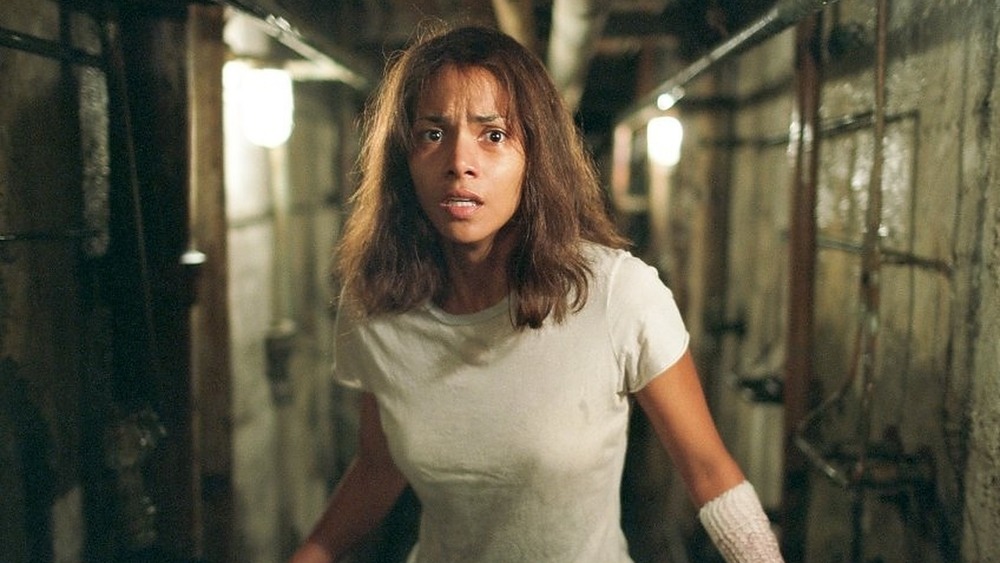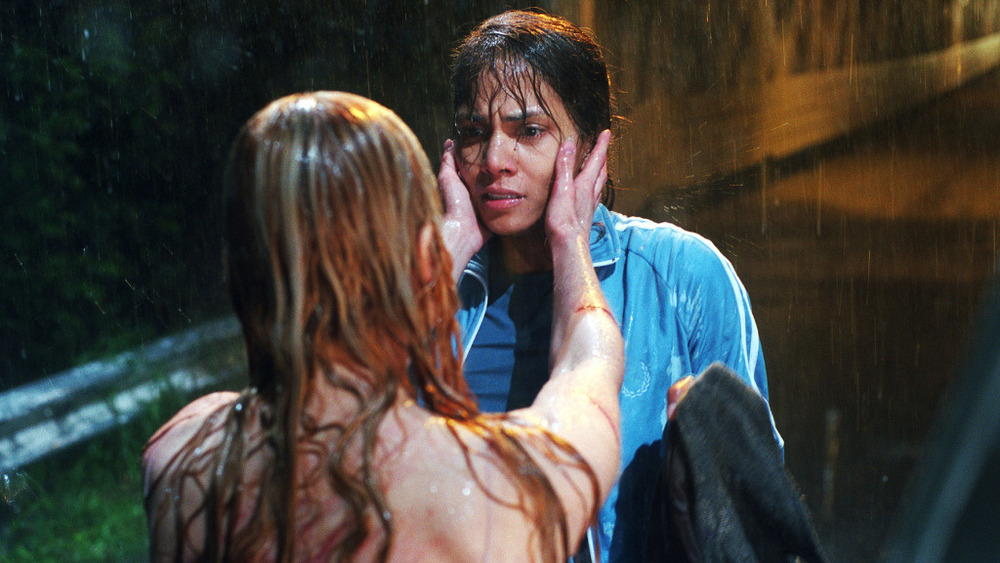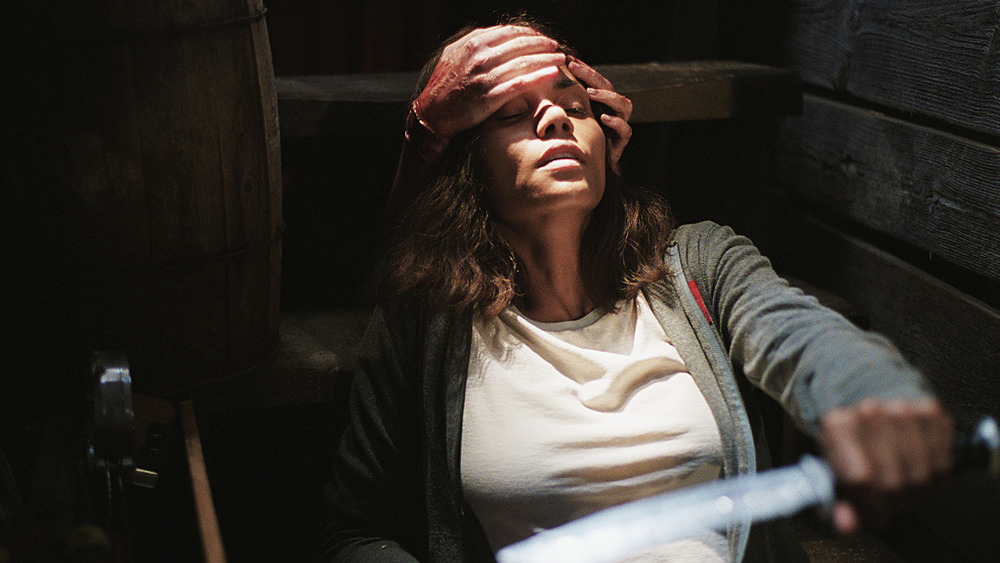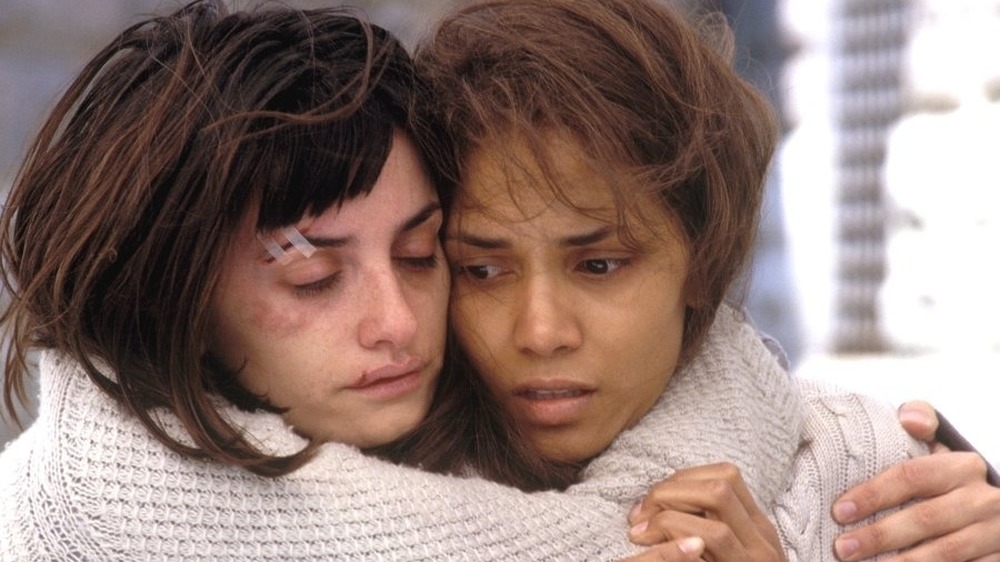The Ending Of Gothika Explained
While Oscar-winner Halle Berry has done quite a few action films in her career — think John Wick 3 and Die Another Day — supernatural thriller Gothika, remains her only horror film. Critically panned, scoring just 15% on the Rotten Tomato meter, the film — released in 2003 and available to stream on Netflix this January — also failed to garner the larger audience box office its studio was looking for. Following its release, Gothika's global earnings were just $141 million on a $40 million budget (via Box Office Mojo). Additionally, the production faced several controversial hiccups. Director Mathieu Kassovitz, then a relative unknown in the states, was brought on last-minute, and Berry was seriously injured after breaking her arm halfway through production filming a scene with co-star Robert Downey, Jr. The injury delayed production by three weeks on a project slated to be shot over just 45 days, according to IGN.
While it may not have been the home run Dark Castle was looking for coming off of successes with Thirteen Ghosts, Ghost Ship, and the remake of House on Haunted Hill, it still manages to scare up a decently good time. While its better-known cast, which includes the aforementioned Berry, Downey, and Penelope Cruz, is part of what works about the film, the thing that keeps you sticking around is the murder mystery — or rather, mysteries — at its center. Gothika centers on the well-respected female psychiatrist Dr. Miranda Grey, who has a frightening encounter after getting into a car accident trying to avoid a strange woman in the road during a thunderstorm. Miranda wakes up three days later as a patient inside the facility she and her husband, Dr. Douglas Grey (Charles S. Dutton), once ran to find that he's now dead, butchered by her own hand despite her having no memory of the incident.
The film follows Miranda as she attempts to unpack what the ghostly figure haunting her is while also trying to convince former co-workers and friends, including Downey's Dr. Pete Graham, that she isn't crazy. If the film's climactic twists and turns aren't enough for you, it's one last parting twist just might be. Here's the ending of Gothika explained.
Halle Berry's Miranda Grey frees herself from a haunted asylum before running into a new house of horrors
After a harrowing experience inside the woman's ward of Woodward Penitentiary, wherein she was not only perpetually gaslit but attacked in the showers and her cell by an entity only she could see, Miranda was finally able to steal the keys off a nurse and escape the facility. From there, she returns to the scene of the crime she has struggled to remember since the beginning of the film — her husband's murder. As she walks the still blood-stained halls, flashes of that fateful night come back to her in chunks.
It's here that she realizes why she doesn't remember what happened to her. The young woman she nearly hit and tried to help just a few nights earlier wasn't alive, and her ghost has somehow possessed her. Distraught over the truth, Miranda returns to her old bedroom, weeping as she sifts through old photos of her and her husband, Dough. It's in this moment, as she picks up a photo of the two at a place called "Willow Creek," that her nose begins to drip blood on the picture frame. Behind the couple is an old farmhouse and barn her husband and his best friend, Sheriff Bob Ryan (John Carroll Lynch), frequently tripped to.
She takes this all as a clue, remembering the night of the storm when Bob directed her away from a flooded road and across the haunted bridge. She quickly heads there and begins searching the grounds, seeing nothing unusual inside the house. The barn is also seemingly crowded with useless things and a single barn owl that delivers to her and viewers a classic jump scare. It isn't until she comes across a door to a room inside the barn that things begin to take a truly sinister turn. Inside is a room of horrors — a torture chamber that becomes real with a flip of a light switch.
Miranda discovers her husband's a violent killer who wasn't acting alone
As Miranda rakes over the bed with bloody sheets and chains and a box full of sedatives, she hears a video camera clicking and moves to find what's on it. As she plays back the most recent footage, she finds her husband torturing a young woman, a deranged, monstrous man far removed from the loving partner she knew. The horror show is interrupted by the sound of footsteps above her, forcing Miranda to hide in a dark corner. But when an officer finds her, the two have a brief stand-off before a pair of bloody arms wrap themselves around Miranda's shoulders as she scrambles to get away. As audiences see, Miranda has not just found evidence of her husband's vicious crimes, but a victim who is very much still living and breathing.
The doctor-turned-patient returns to town, where her lawyer, Teddy Howard (Dorian Harewood), and the Sheriff frantically discuss the situation while Miranda has a chance to tell her supervisor — and the father of Rachel, her husband's ghostly victim — what happened. Everyone is in shock, but Miranda still has questions. After having the words "Not Alone" cut into her arm and seeing it smeared in blood on the walls of her house, as well as seeing the repeated imagery of the Anima Sola — a burning woman — again and again, the psychiatrist requests the Sherrif in hopes that he can help her put the loose pieces together.
As the two talk more and more, Miranda admits everything she knows about a potential second killer — a different theory about the "Not Alone" messages being a reference to more than one murdered woman. The more she spills, the more visibly unsettled Bob becomes until eventually, he reveals his true self as Doug's murderous partner. With just him and Miranda at the station, Bob attempts to sedate and torture her before she narrowly escapes, and the situation devolves into a cat and mouse scenario where Miranda must fight for her life.
Dr. Miranda Grey finally realizes that she can now "see" the truth — and ghosts — others cannot
With Bob armed and no way out of the office, Miranda attempts to hide but finds the "Not Alone" message again taking on new meaning. The ghost of Rachel appears, muddling her appearance with the reflection of Miranda's face and disorienting Bob. He shoots at the specter, expecting to kill Miranda but instead firing at the ghost of his victim. That's when he shoots again, and this time, the shot sparks an explosion — thanks to a leaking gas pipe Bob hit while trying to capture Miranda earlier. The Sheriff goes up in flames, a new embodiment of the Anima Sola image before Miranda puts a bullet through his head. As she works to catch her breath, she turns to see Pete at the door, looking concerned as he mouths that he's sorry.
Miranda is next seen strolling down the street with her former patient, Chloe Sava (Penélope Cruz), a year after the event. Released from Woodward Penitentiary, she is on her way to a train to begin her life again, free from her literal and figurative prisons. As the two walk side-by-side, Chloe tells Miranda that she still has nightmares, but that despite everyone thinking they were both crazy, the reality was that they could see the truth more than their doubters. "Once you open that door, you can never close it," Chloe explains before embracing Miranda and hopping into a cab.
As Miranda continues down the sidewalk, she suddenly sees a little boy standing in the middle of the rainy street. Seeing a bus fast approaching, she moves to help him but stops herself as he points at her, the bus barreling through like the driver doesn't even see the boy. And as viewers and Miranda quickly discover, they don't — the boy is an apparition like Rachel, calling to Miranda. His ghostly fate — and Miranda's new ability to "see" the other side — is confirmed by the film's last image: a flyer declaring him missing.



